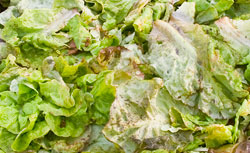?/?
food
?:?
What to eat. What not to eat.Posted Wednesday, Aug. 10, 2011, at 10:04 AM ET There were warning signs. After stirring a quintuple batch of roux for a full hour, hacking apart dozens of alliums and a 5-pound kielbasa, and sluicing in 10 quarts of chicken stock, a strange scum appeared. It was gray, bubbly, and slightly fetid. But there was salad to toss, bread to cut, a table to set, toys to hide, and a husband to berate about mopping the floor. By the time I returned to the stove?ready to add the finishing touch, $100 worth of rock shrimp?the pot was a foamy, churning mass, reminiscent of an underwater sewage break. I paused for a moment, then did what any desperate hostess would do under the circumstances: I bailed ladleful after ladleful of stinky froth, pitched in the crustaceans, and clapped down the lid.
There were warning signs. After stirring a quintuple batch of roux for a full hour, hacking apart dozens of alliums and a 5-pound kielbasa, and sluicing in 10 quarts of chicken stock, a strange scum appeared. It was gray, bubbly, and slightly fetid. But there was salad to toss, bread to cut, a table to set, toys to hide, and a husband to berate about mopping the floor. By the time I returned to the stove?ready to add the finishing touch, $100 worth of rock shrimp?the pot was a foamy, churning mass, reminiscent of an underwater sewage break. I paused for a moment, then did what any desperate hostess would do under the circumstances: I bailed ladleful after ladleful of stinky froth, pitched in the crustaceans, and clapped down the lid.
The going-away party for Hilary went off without a hitch. I greeted each guest with a steaming bowl of shrimp and sausage gumbo?the perfect antidote to a cold January night?and a glass of wine, then directed her to the dining room. We told stories about our friendship with Hilary, presented her with a scrapbook, and promised to visit her in Quer?taro, a university city in central Mexico. I did notice, with an odd feeling of relief, that quite a few people had left their gumbo half-eaten or untouched. Except for Amita, Hilary's workmate. "Oh, this is sooo good," she'd said, refilling her bowl for the third time, as I quashed the impulse to wrest it from her hands. After the last person had left, I served myself and finally sat down. Completely putrid. I poured the evidence down the disposal and went to bed, trying very hard not to think the words food poisoning.
The CDC estimates that 48 million people get sick from foodborne viruses, bacteria, or parasites every year. I've been one of them. Here in the United States, my most frequent complaint has been post-restaurant stomachache, undoubtedly from norovirus, which is both extremely common?58 percent of the 9 million cases from known pathogens are attributed to it?and quite mild?fewer than .00003 percent of them die. It's Latin America, where I've lived and often travel, that has been my undoing, digestively speaking. In Honduras after a bus ride, I paid for a stack of banana-leaf-wrapped tortillas first with lempiras and then with three straight days of toilet-perching. In Ecuador, after snacking on a bola verde (plantain and meat ball) from a restaurant display case, I had to sprint to my apartment?luckily nearby?to spend an hour vomiting and going cheek-to-tile with the bathroom floor.
Fully versed with the icky effects of enteric diseases, I've always?well, except under the duress of entertaining?given spoiled food a wide berth. After all, why would nature have bothered with the poison labels (nasty smell, gross appearance, foul taste) if ingesting it didn't make you sick? Ergo, my relentless crusade against senescent foodstuffs. Not a day goes by that I don't discover in the hinterlands of my refrigerator sour milk, yellowing broccoli, mushy lettuce, powder-covered lemons, slimy lunch meat, moldy cheese, or the venerable remains of takeout and home-cooked meals. Out! In this policy I have plenty of company: Americans chuck an estimated 16 percent of their food uneaten, either because it goes bad, they prepare too much, or they're spooked by expired use-by/open dates. A sensible precaution, except for one thing: In my experience, every gastrointestinal illness has been preceded by consuming something that seemed perfectly fresh.
Could it be that eating spoiled food doesn't actually make you sick? To find out, I dusted off my high-school biology and spent weeks devouring peer-reviewed studies by food microbiologists. Here's what I learned.
To spoil, something must be dead, which, unless you're a fan of mollusks on the half-shell or maggot-infested Sardinian casu marzu, is generally how we prefer our food. Once this unfortunate event has occurred, the plant or animal tissue is fair game for invasion by decomposers?the omnipresent yeasts, molds, and bacteria. We'll gloss over the first two, as they are almost always innocuous. (Some molds produce dangerous mycotoxins on crops and stored fruits and grains, but this is an agricultural hazard, not a household one.) When it comes to bacteria, however, things get complicated. The reason: There are two distinct types that invade edibles. Once you understand their different ecological niches, you'll never confuse them again.
Like Slate Culture on Facebook. Follow Slate on Twitter.
Anastacia Marx de Salcedo is a food writer.Photograph of rotting lettuce by iStockphoto.
Source: http://feeds.slate.com/click.phdo?i=968cdcfebcca550a8328818b46b184b4
hiroshima ci paradise robert de niro johnny depp san francisco chronicle napoleon dynamite
No comments:
Post a Comment
Note: Only a member of this blog may post a comment.